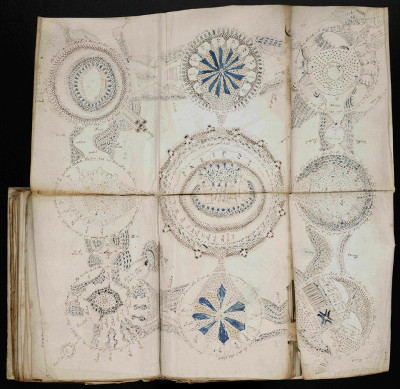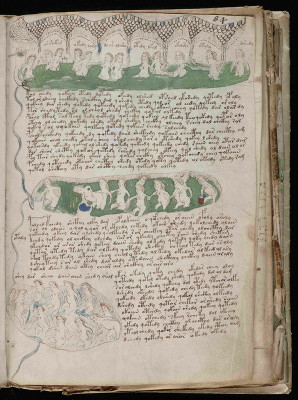The age of unbreakable fiction book "Voynich manuscript" is specified

It is written in a mysterious character not seen anywhere else, and it is unknown what kind of written in what language is written an ancient document "Voynic manuscript". There is also the charm of numerous inexplicable illustrations that are unknown even if they are related to the text, and since then discovered in Italy in 1912, I have kept tickling the hearts of old maniacs and cryptographers since then.
Up to now it has been thought that this "Voynich manuscript" was created around the 14th century to the 16th century,University of ArizonaWas done atMass spectrometryIt seems that the age was specified by.
Details are as below.UA Experts Determine Age of Book 'Nobody Can Read' | UANews.org
"Voynich manuscript" was discovered in Mondragone Temple near Rome in 1912, an archaeologist who is the discovererWilfrid VoynichNamed after the "Voynich manuscript." Voynich had struggled to identify the identity of the mysterious manuscript and tried to decipher the content, but until the death of 18 years from discovery, its contents could not be traced down even the age.

The manuscript is written by special artificial letters mixed with letters similar to the Latin alphabet or letters that do not resemble any known letters and statistical methods that analyze the appearance frequency of each letter or character string Although it is judged as a sentence string which has certain meaning rather than a random word character string, it has not been decrypted even now even after nearly a century since discovery.
Pictures that look like people bathe in the public bath. It seems that it is impossible to specify the age from clothes, because the person being drawn (the one that seems to be) is just naked.

CurrentlyYale UniversityAssociate Professor of Physics Department of University of Arizona, although it is in the attached Baineki rare book manuscript libraryGreg HodginsDr. and colleagues cooperated with Yale University to prepare manuscriptsparchmentSamples of "Voynich manuscript" by accelerator mass spectrometry1404 - 1438I identified it. It means that it was 100 years old than the theory of the first half of the 16th century, which had been considered to be strong.
Dr. Hodgins who carefully collects samples as Christine McCarthy, a rare library staff member at Yale University watches. It seems that samples of small parchment of about 1 mm × 6 mm were cut out from each of four pages.

ArizonaTucsonSince it is thought that any "dirt" such as adhesive of the fingers of human fingers and books to bind books is attached to the parchment which we brought back to the laboratory of the laboratory, we first remove them thoroughly and then pure I got a sample of carbon. These carbons were placed in an accelerator,Carbon 14It seems that we succeeded in identifying the age by examining the ratio of
University of ArizonaAccelerator.

Most of the carbon atoms on the earth are 6 protons and 6 neutronsCarbon 12It is stable isotope of 6 protons and 7 neutronsCarbon 13There is also about 1.1%. Carbon 14, which is a radioactive isotope of 6 protons and 8 neutrons, is much smaller than that, and the extent to which one is present in 10 billion (0.00000000012%). Since carbon 13 is heavier than carbon 12 by one neutron and carbon 14 is heavier than carbon 13, its abundance ratio can be determined by mass spectrometry.
In the body such as plants and animalsOrganic compoundSince carbon is constantly replaced by photosynthesis, diet, excretion, etc., carbon 14 keeps the ratio of 1 in 10 billion carbon atoms while living, but as it is dead carbon , The radioactive carbon 14 among the carbons accumulated during the living period isHalf lifeIt will decrease in the pace of 5730. This means that it is possible to measure the age of how many years have passed since trees were cut, and how many years after death the animal's bone. Since the parchment used in "Voynich manuscript" is made of animal skin it was possible to dating with carbon.
This time the age of parchment used in the manuscript was specified and the age when the manuscript was written can not be said to have been specified, but in the analysis by art historian etc, the color of ink and paint isRenaissanceIt seems to be consistent with what was available at the time. "It would be ideal if it would be ideal if we could measure the age from the radioactive carbon of the ink, but there are some challenges: firstly the ink is only a small amount on the surface of the parchment and a sufficient amount of carbon sample In addition, it is impossible with current technology to separate carbon sample of ink without mixing carbon of parchment.In addition, it is impossible to separate carbon sample of ink from carbonaceous matter, In case it is inorganic matter and does not contain carbon at all in the first place, "Hodgins says.
It seems that pigments containing almost no carbon are used in colored parts such as green, red, and blue. Even if the ink with written letters is a carbon-based one with charcoal dissolved, it is difficult to remove the sample from the parchment and it is difficult to collect the sample, which will destroy valuable old books.

People in various fields have tried to explore the history and meaning of Voynich manuscripts, but Dr. Hosgins, a physicist, is also attracted to that mystery.
"We are not specializing except to specify the age," but in advance, "Nobody knows what is being written." The ancient cryptographic method of reading with a holey paper There is also the possibility that most of what is written does not make any sense at all.alchemyIt seems like a topic related to the secretive alchemy tradition, if the manuscript is cryptic. And these are the illustrations that are more interesting than anything else. What on earth is being drawn? Is it a plant? Is it a marine organism? Is there anything related to astronomy? No one knows it, "Dr. Hosgins says. "The manuscript is as dazzling as a window that you can look into a very interesting head of a person, so the manuscript is unattractive, does anyone not be attracted by a puzzle that no one has solved?"
In addition, you can see the high resolution image of each page of this "Voynich manuscript" from the following. Just imagining the contents written while watching an illustration may be interesting.
VoynichCentral.com | Voynich Gallery
Related Posts:
in Science, Posted by darkhorse_log







